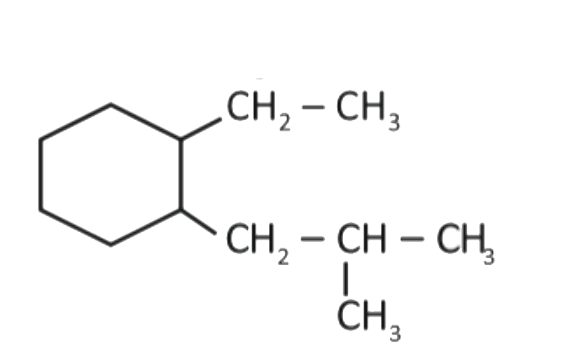2,3-dimethyl hexane contains …....., Tertialy ….............. Secondary and …...............Primary carbon atoms,respectively.
2,2,4
2,4,3
4,3,2
3,2,4
To solve the question regarding the number of primary, secondary, and tertiary carbon atoms in 2,3-dimethylhexane, we will follow these steps:
Step 1: Understand the Definitions
- Primary Carbon: A carbon atom that is attached to only one other carbon atom.
- Secondary Carbon: A carbon atom that is attached to two other carbon atoms.
- Tertiary Carbon: A carbon atom that is attached to three other carbon atoms.
Step 2: Draw the Structure of 2,3-Dimethylhexane
1. Hexane Base: Start with the hexane backbone, which consists of six carbon atoms in a straight chain:
- C1 - C2 - C3 - C4 - C5 - C6
2. Add Methyl Groups: According to the name 2,3-dimethylhexane, we add:
- A methyl group (-CH₃) at carbon 2.
- A methyl group (-CH₃) at carbon 3.
The structure can be represented as:
CH3|CH3−CH−CH−CH2−CH2−CH3|CH3
Step 3: Identify Each Carbon Atom
- Carbon 1 (C1): Attached to 1 carbon (C2) → Primary
- Carbon 2 (C2): Attached to 3 carbons (C1, C3, and C2 from the methyl group) → Tertiary
- Carbon 3 (C3): Attached to 3 carbons (C2, C4, and C3 from the methyl group) → Tertiary
- Carbon 4 (C4): Attached to 2 carbons (C3 and C5) → Secondary
- Carbon 5 (C5): Attached to 2 carbons (C4 and C6) → Secondary
- Carbon 6 (C6): Attached to 1 carbon (C5) → Primary
Step 4: Count the Carbon Types
- Primary Carbons: C1, C6 → 2 Primary Carbons
- Secondary Carbons: C4, C5 → 2 Secondary Carbons
- Tertiary Carbons: C2, C3 → 2 Tertiary Carbons
Final Answer
2,3-dimethylhexane contains 2 tertiary, 2 secondary, and 2 primary carbon atoms, respectively.
Summary
- Tertiary Carbons: 2
- Secondary Carbons: 2
- Primary Carbons: 2
- Primary Carbon: A carbon atom that is attached to only one other carbon atom.
- Secondary Carbon: A carbon atom that is attached to two other carbon atoms.
- Tertiary Carbon: A carbon atom that is attached to three other carbon atoms.
1. Hexane Base: Start with the hexane backbone, which consists of six carbon atoms in a straight chain:
- C1 - C2 - C3 - C4 - C5 - C6
- A methyl group (-CH₃) at carbon 2.
- A methyl group (-CH₃) at carbon 3.
CH3|CH3−CH−CH−CH2−CH2−CH3|CH3
- Carbon 1 (C1): Attached to 1 carbon (C2) → Primary
- Carbon 2 (C2): Attached to 3 carbons (C1, C3, and C2 from the methyl group) → Tertiary
- Carbon 3 (C3): Attached to 3 carbons (C2, C4, and C3 from the methyl group) → Tertiary
- Carbon 4 (C4): Attached to 2 carbons (C3 and C5) → Secondary
- Carbon 5 (C5): Attached to 2 carbons (C4 and C6) → Secondary
- Carbon 6 (C6): Attached to 1 carbon (C5) → Primary
- Primary Carbons: C1, C6 → 2 Primary Carbons
- Secondary Carbons: C4, C5 → 2 Secondary Carbons
- Tertiary Carbons: C2, C3 → 2 Tertiary Carbons
2,3-dimethylhexane contains 2 tertiary, 2 secondary, and 2 primary carbon atoms, respectively.
- Tertiary Carbons: 2
- Secondary Carbons: 2
- Primary Carbons: 2
Topper's Solved these Questions
- INTRODUCTION TO ORGANIC CHEMISTRY BOOK - VMC MODULES ENGLISHCHAPTER - INTRODUCTION TO ORGANIC CHEMISTRY EXERCISE - LEVEL 2
49 Videos
- INTRODUCTION TO ORGANIC CHEMISTRY BOOK - VMC MODULES ENGLISHCHAPTER - INTRODUCTION TO ORGANIC CHEMISTRY EXERCISE - LEVEL 2 (Numerical value type )
15 Videos
- INTRODUCTION TO ORGANIC CHEMISTRY BOOK - VMC MODULES ENGLISHCHAPTER - INTRODUCTION TO ORGANIC CHEMISTRY EXERCISE - JEE ADVANCED ARCHIVE
81 Videos
- ICONIC EQUILIBRIUMBOOK - VMC MODULES ENGLISHCHAPTER - ICONIC EQUILIBRIUMEXERCISE - IMPECCABLE
50 Videos
- IONIC EQUILIBRIUMBOOK - VMC MODULES ENGLISHCHAPTER - IONIC EQUILIBRIUMEXERCISE - IN - CHAPTER EXERCISE - K
10 Videos
Similar Questions
Knowledge Check
Assertion: 2,2-Dimethylbutane does not have any tertiary carbon atom.
Reason: Tertiary carbon atom is attached to three carbon atoms.AIf both assertion and reson are true and reason is the correct explanation of assertionBIf both assertion and reason are true but reason is not the correct explanation of assertion.CIf assertion is true but reason is false.DIf both assertion and reason are false.
The -hybridisations of central and terminal carbon atoms in are respectively

View SolutionThe number of primary, secondary and tertiary carbons in the following, structure are respectively

View SolutionNumber of secondary carbon atoms present in the compounds is respectively :

View SolutionHow many secondary and tertiary C - atoms are present in this compound respectively ?

View SolutionNumber of primary, secondary and tertiary hydrogen in the following are respectively

View SolutionFor a transformer, the turns ratio is 3 and its efficiency is 0.75. The current flowing in the primary coil is 2A and the voltage applied to it is 100 V. Then the voltage and the current flowing in the secondary coild are..............respectively.
View SolutionPalmitic acid contains - number of carbon atoms
View Solution
